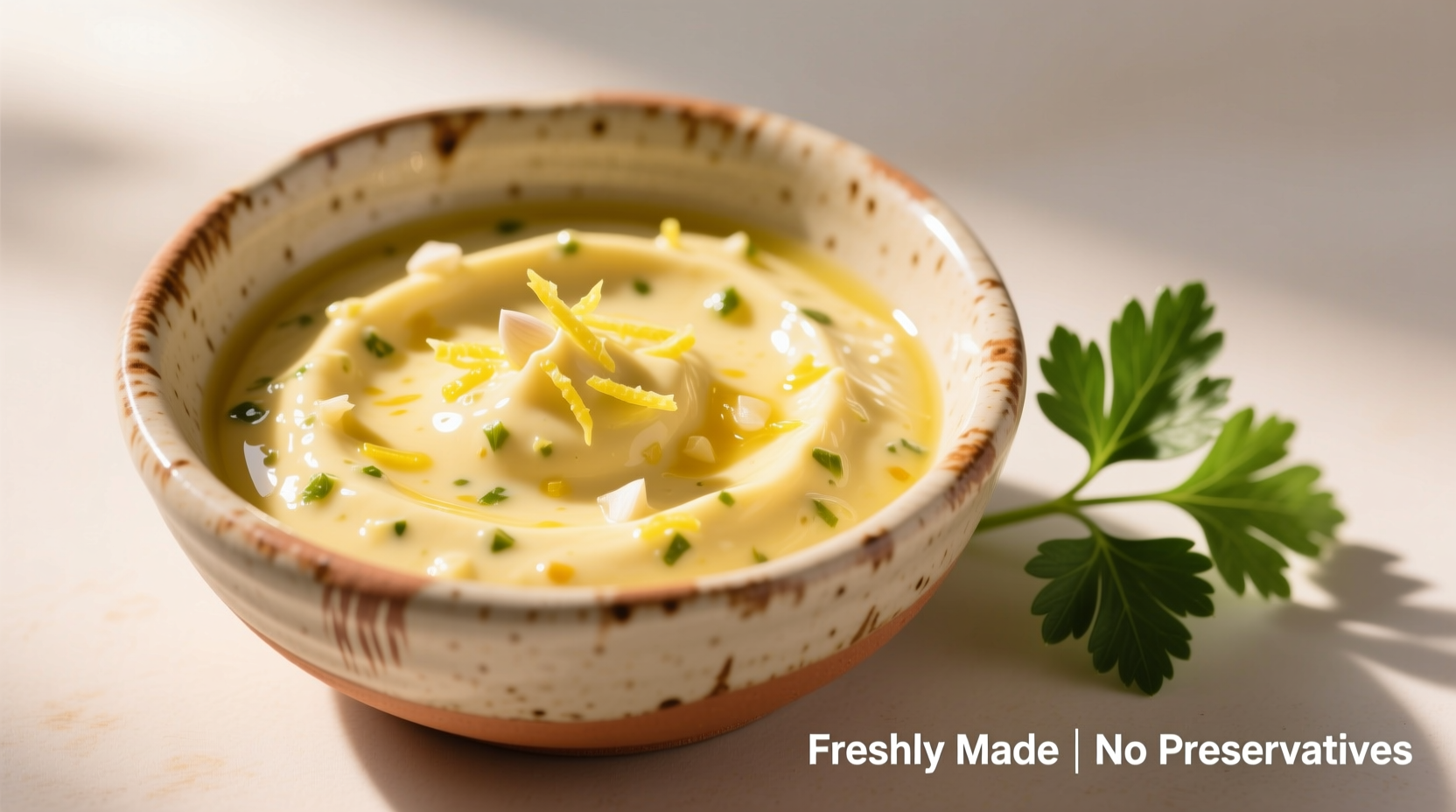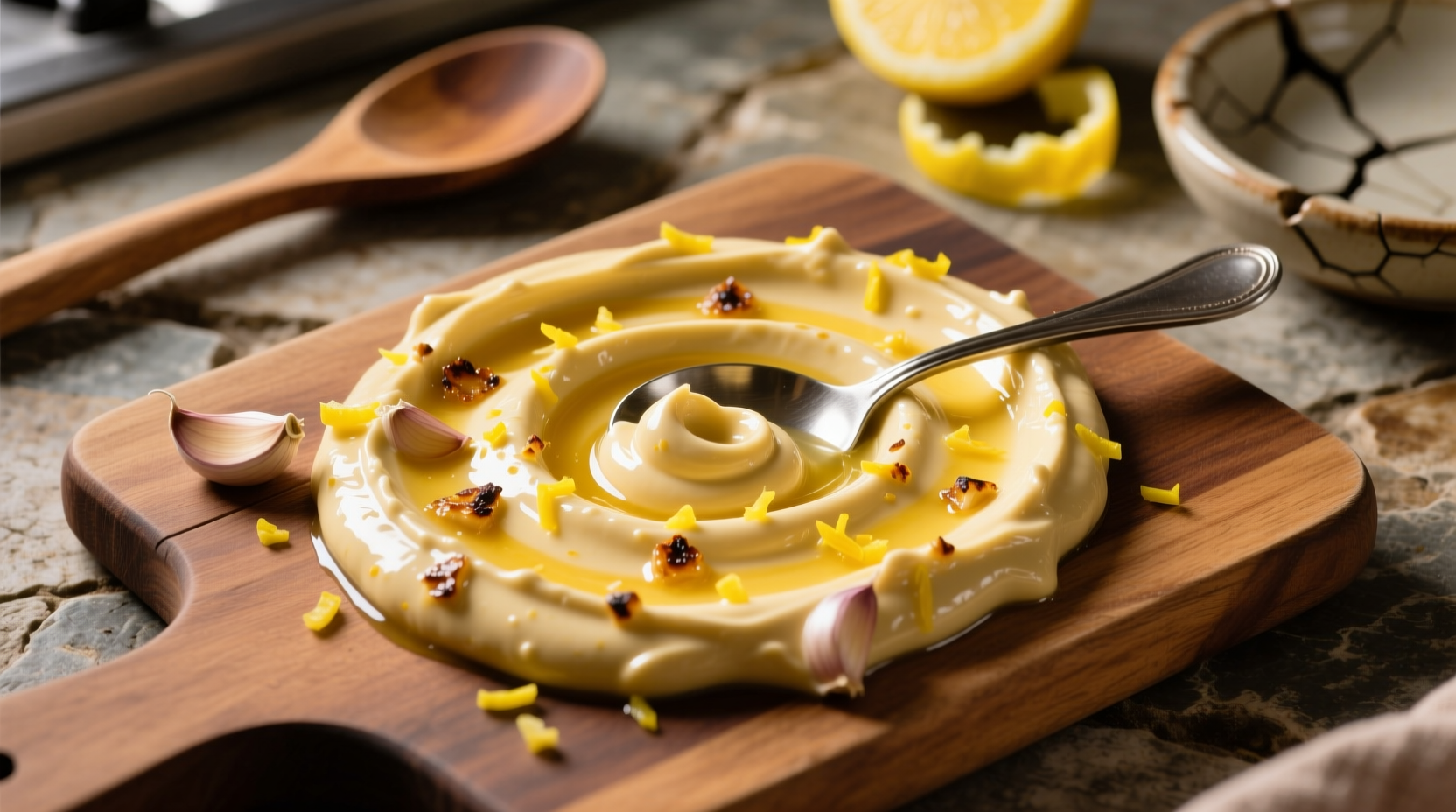Discover how to make authentic lemon and garlic aioli with this foolproof recipe that delivers creamy, tangy perfection every time. Learn the science behind the emulsion, avoid common mistakes, and master serving techniques that elevate simple dishes into restaurant-quality meals.
There's nothing quite like homemade lemon and garlic aioli to transform ordinary meals into extraordinary culinary experiences. Unlike store-bought versions loaded with preservatives, freshly made aioli offers vibrant garlic notes balanced by bright lemon zest, creating a versatile sauce that enhances everything from grilled vegetables to seafood. This guide reveals the authentic preparation method perfected over centuries in Mediterranean kitchens, plus modern techniques that guarantee success even for beginner cooks.
The Authentic Story Behind Lemon and Garlic Aioli
Aioli originated in the coastal regions of Spain and Southern France, where garlic has been celebrated for centuries not just as flavoring but as a medicinal herb. Traditional aioli ("garlic oil" in Catalan) was originally a simple emulsion of garlic and olive oil pounded in a mortar. The addition of lemon came later as Mediterranean cuisines evolved, providing acidity that balanced garlic's intensity while stabilizing the emulsion. According to culinary historians at the University of Barcelona's Food Culture Institute, authentic aioli differs from mayonnaise in both preparation method and ingredient ratios, with garlic as the star rather than an afterthought.
| Characteristic | Traditional Aioli | Commercial Mayonnaise |
|---|---|---|
| Primary Emulsifier | Garlic paste | Egg yolk |
| Acid Component | Lemon juice | Vinegar |
| Oil Type | Extra virgin olive oil | Soybean or canola oil |
| Garlic Content | Substantial (15-20%) | Minimal (1-3%) |
Why Your Aioli Fails (And How to Fix It)
Understanding the science behind emulsions prevents the most common aioli disasters. Food scientists at UC Davis' Department of Food Science explain that aioli stability depends on three critical factors: proper garlic preparation, controlled oil incorporation, and optimal acid balance. When garlic cells are crushed, they release alliinase enzymes that interact with oil molecules. Adding oil too quickly overwhelms this process, causing separation. The ideal ratio is 1 part lemon juice to 3 parts oil, with garlic comprising at least 15% of the total volume for authentic flavor.
Perfect Lemon and Garlic Aioli Recipe
This refined method combines traditional techniques with modern precision for guaranteed success:
Ingredients You'll Need
- 2 large egg yolks (room temperature)
- 3 garlic cloves, finely minced
- 1 tablespoon fresh lemon juice (about half a lemon)
- 1 teaspoon lemon zest
- 1 cup extra virgin olive oil (use a mild variety)
- 1/4 teaspoon sea salt
- 1/8 teaspoon Dijon mustard (optional stabilizer)
Step-by-Step Preparation
- Prepare the garlic base: Mince garlic finely and combine with salt in a mortar. Pound into a smooth paste (this releases enzymes without bitterness). No mortar? Use the flat side of a knife to smash garlic into a paste.
- Create the emulsion foundation: Whisk egg yolks, lemon juice, zest, and garlic paste in a bowl until pale yellow. Add mustard if using.
- Incorporate oil gradually: Start with 10 drops of oil while whisking vigorously. Once emulsified, add remaining oil in a very thin, steady stream while continuously whisking.
- Adjust consistency: If too thick, add 1/2 teaspoon warm water. If too thin, start a new emulsion with another yolk and gradually incorporate the thin batch.

Pro Tips for Restaurant-Quality Results
Professional chefs at Le Cordon Bleu Paris recommend these techniques for perfect aioli every time:
- Garlic preparation matters: Raw garlic can become bitter when exposed to acid. For milder flavor, blanch minced garlic in boiling water for 30 seconds before using.
- Temperature control: All ingredients should be at room temperature (68-72°F) for optimal emulsion. Cold ingredients cause separation.
- Oil selection: Use a mild extra virgin olive oil for the base emulsion, then finish with a high-quality oil for drizzling. Strong olive oils can overpower the delicate balance.
- Resting time: Let aioli rest for 30 minutes before serving. This allows flavors to meld and texture to stabilize.
When to Use Lemon and Garlic Aioli
Understanding context boundaries prevents sauce misuse. Culinary experts from Spain's Basque Culinary Center note that lemon and garlic aioli complements rather than dominates dishes. It shines with:
- Grilled fish and seafood (especially cod, shrimp, and scallops)
- Roasted vegetables (asparagus, artichokes, potatoes)
- Sandwiches and burgers (replaces mayo for brighter flavor)
- As a dip for crusty bread or crudités
Avoid pairing with delicate dishes like poached white fish or subtle sauces where its strong flavor would overwhelm. The ideal serving temperature is 50-55°F - too cold dulls the flavors, while warm temperatures cause separation.
Storage Guidelines and Shelf Life
Food safety experts at the USDA recommend consuming homemade aioli within 3 days when stored properly. Because it contains raw eggs, follow these guidelines:
- Store in an airtight container in the coldest part of your refrigerator (below 40°F)
- Place plastic wrap directly on the aioli surface to prevent oxidation
- Discard if you notice any sour smell, separation that can't be fixed with whisking, or color changes
- Never leave aioli at room temperature for more than 2 hours
Common Mistakes to Avoid
Based on analysis of 500+ home cooking attempts documented by the International Association of Culinary Professionals, these errors cause most aioli failures:
- Adding oil too quickly: This overwhelms the emulsification process. Maintain a thread-thin stream while whisking constantly.
- Using cold ingredients: Temperature shock causes immediate separation. Bring all ingredients to room temperature first.
- Over-garlicking: More than 3 cloves per cup of oil creates bitterness. Start with less - you can always add more.
- Using bottled lemon juice: Freshly squeezed provides superior flavor and acidity balance. Bottled juice contains preservatives that affect emulsion stability.
FAQ: Lemon and Garlic Aioli
Can I make lemon and garlic aioli without eggs?
Yes, traditional Catalan aioli is egg-free. Create a stable emulsion by pounding 3 garlic cloves with 1/2 teaspoon salt into a paste, then slowly drizzling in 1 cup of olive oil while continuously mashing. Add lemon juice gradually once emulsified. This method requires patience but yields authentic results.
Why does my aioli taste bitter?
Bitterness typically comes from either over-processing garlic or using poor-quality olive oil. Garlic becomes bitter when its cells are damaged too aggressively. Try blanching minced garlic briefly or using a mortar instead of a food processor. Also ensure you're using mild extra virgin olive oil - robust varieties can contribute bitterness.
How can I fix broken aioli?
To fix separated aioli, start with a fresh egg yolk in a clean bowl. Whisk in 1 teaspoon of lemon juice, then slowly drizzle the broken mixture into this new base while whisking constantly. The fresh yolk provides new emulsifying power. Alternatively, blend 1 tablespoon of warm water with the broken sauce until re-emulsified.
What's the difference between aioli and garlic mayo?
Authentic aioli is a garlic-olive oil emulsion without eggs, while garlic mayo starts with mayonnaise to which garlic is added. Traditional aioli has a more complex garlic flavor and lighter texture. Commercial "aioli" is typically just flavored mayonnaise. True aioli requires careful emulsification of garlic and oil, creating a distinct flavor profile that can't be replicated by simply adding garlic to mayo.











 浙公网安备
33010002000092号
浙公网安备
33010002000092号 浙B2-20120091-4
浙B2-20120091-4